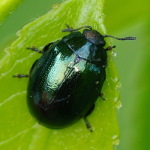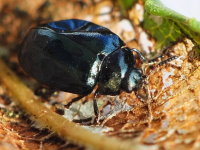Phylum Arthropoda (Arthropods) ➔ Subphylum Hexapoda (Hexapods) ➔ Class Insecta (Insects) ➔ Order Coleoptera (Beetles) ➔ Family Chrysomelidae (Leaf beetles)
Plagiodera versicolora (Laicharting, 1781)
Breiter Weidenblattkäfer Imported Willow Leaf Beetle
Synonyms and other combinations:
Chrysomela versicolora Laicharting, 1781 | Chrysomela armoraciae Fabricius, 1775 nec Linnaeus, 1758 |
Further vernacular names:
Willow Leaf BeetleClassification:
Plagiodera versicolora belongs to the subfamily Chrysomelinae, tribe Chrysomelini.Distribution:
Palearctic, introduced into North America.Habitat:
River floodplains, paludal forests, swamps, bogs.Description:
Length 2.5 - 4.5 mm; body rounded to oval; upper side metallic blue, green or coppery coloured; elytra flat arched with clearly protruding shoulder bulge, at the tip rounded with dimple in the apical angle, irregularly punctured, in the shoulder angles with short longitudinal dimples; elytra somewhat coarser than the pronotum punctured; underside, femora and tibiae black.Plagiodera versicolora is the only species of the genus in Europe.
Biology:
The Willow Leaf Beetle Plagiodera versicolora lives mostly on willows (Salix), more rarely on poplars (Populus). The species is often found on white willow, crack willow or purple willow. Narrow-leaved, hairless willow species with a relatively low concentration of phenyl glycosides are preferred.The adults of Plagiodera versicolora appear at the end of April from their winter shelters and feed holes in the leaves of the host plants. They are macropter and well able to fly. The females mate several times. About 7 to 10 days later the yellowish eggs are laid in small groups on the undersides of the leaves. After about 10 days the larvae hatch. These live cannibalistically at first, stay together later in the group, eat together at one leaf and move to the next leaf, if the previous one is skeletonized. The larvae pass through 3 larval stages. The older larvae separate and pupate on the underside of a leaf. The entire development takes about 4 weeks.
In total, about 2 - 3 overlapping generations can be passed through per year. Plagiodera versicolora hibernates in protected places in the leaves layer or under bark.
References, further reading, links:
- Rheinheimer, Joachim, & Hassler, Michael: Die Blattkäfer Baden-Württembergs, 2018, 928 pages, Kleinsteuber Books (Karlsruhe), ISBN 978-3-9818110-2-5
- Arved Lompe: Die Käfer Europas - Ein Bestimmungswerk im Internet
- Agelastica alni
- Altica sp.
- Aphthona nonstriata
- Bromius obscurus
- Bruchus rufimanus
- Bruchus sp.
- Cassida nebulosa
- Cassida rubiginosa
- Cassida sp.
- Cassida stigmatica
- Cassida vibex
- Cassida vibex/bergeali
- Cassida viridis
- Chrysolina fastuosa
- Chrysolina haemoptera
- Chrysolina hyperici
- Chrysolina lucidicollis
- Chrysolina oricalcia
- Chrysolina sp.
- Chrysolina sturmi
- Chrysolina varians
- Chrysomela populi
- Chrysomela tremula
- Chrysomela vigintipunctata
- Clytra laeviuscula
- Clytra quadripunctata
- Coptocephala sp.
- Crepidodera aurata
- Crepidodera aurea
- Crepidodera fulvicornis
- Crioceris duodecimpunctata
- Cryptocephalinae sp.
- Cryptocephalus moraei
- Cryptocephalus nitidus
- Cryptocephalus pusillus
- Cryptocephalus sp.
- Donacia bicolora
- Donacia cinerea
- Donacia marginata
- Donacia versicolorea
- Galeruca tanaceti
- Galerucella s.l.
- Gastrophysa viridula
- Gonioctena decemnotata
- Gonioctena quinquepunctata
- Gonioctena quinquepunctata/intermedia
- Gonioctena sp.
- Gonioctena viminalis
- Lema cyanella
- Leptinotarsa decemlineata
- Lilioceris lilii
- Lochmaea caprea
- Neocrepidodera ferruginea
- Neocrepidodera sp.
- Oulema melanopus/duftschmidi
- Oulema obscura
- Pachybrachis sp.
- Phratora sp.
- Phratora vitellinae
- Phyllobrotica quadrimaculata
- Phyllotreta armoraciae
- Phyllotreta nemorum
- Phyllotreta vittula
- Plagiodera versicolora
- Plagiosterna aenea
- Plateumaris sp.
- Podagrica fuscicornis
- Psylliodes sp.
- Pyrrhalta viburni
- Sphaeroderma sp.
- Xanthogaleruca luteola

